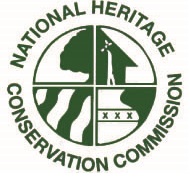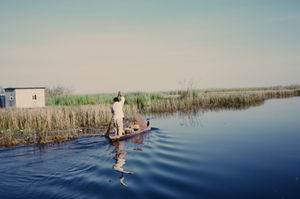National Heritage Conservation Commission
 | |
| Founded | 1948 |
|---|---|
| Headquarters | Lusaka,Zambia |
| Website | nhcc |
| Type | Historic house |
|---|---|
| Nearest car park | Yes |
| Website | nhcc |
The National Heritage Conservation Commission[lower-alpha 1] formally known as Commission for the Preservation of Natural and Historical Monuments and relics (National Monuments Commission) until 29th December 1989 is a governmental body concerned[1]
History
Untill 1996, the Commission only operated from Livingstone. However, after 1996, it decentralised its operations by opening four regional offices. The East Central Office based in Lusaka is responsible for the management and conservation of all heritage resources in Eastern, Central and Lusaka Provinces while the Northern Region, with its office based in Kasama, covers Luapula and Northern Provinces. The North West Office covers North-Western and Copperbelt Provinces and its regional office is based in Solwezi. Finally, Livingstone's based South West Office is charged with the task of managing heritage resources in Southern and Western Provinces. Among other objectives for this decentralisation programme was to bring conservation staff closer to where the heritage resources were located. Its long term objective was to enhance the effective conservation and management of Zambia's unique heritage.
NHCC Declared National Monuments
Prehistoric Monuments
<templatestyles src="Div col/styles.css"/>
- Ayrshire Farm Rock Engravings, Lusaka
- Chifubwa Stream Cave 6.4 km from Solwezi at 12°13' S 26°25' E.
- Gwisho Hot-Springs, Lochinvar National Park, Monze: Late Stone Age human skeletons from about 4,000 years ago.
- Ing-ombe Ilede, Lusitu, is an archaeological site near the town of Siavonga, at 16°11' S 28°19' E.
- Kalemba Rock Shelter, Chadiza District, with many rock paintings, at 14°7' S 32°30' E.
- Kalundu Mound, Kalomo, site of a village from at least the ninth century until the twelfth century.
- Kasamba Stream Grinding Grooves, Samfya — Iron Age site 1.6 km south of boma where axes and iron implements were sharpened, at 11°20' S 29°33' E.
- Kundabwika Rock Painting — near Kundabwika Falls, 96 km north-west of Mporokoso at 9°13' S 29°19' E.
- Leopard's Hill Cave, Lusaka District.
- Libala Limestone, Lusaka next to Lusaka Primary School along Chilimbulu road.
- Makwe Rock Shelter, Katete: Late Stone Age site which yielded many tools, (6000 years old) 3.2 km S of Kondwelani School, at 14°24' S, 31°56' E
- Maramba Quarry Site, Livingstone — first stratified site of the Middle Pleistocene Hope Fountain Culture in Southern Africa, north side of town.
- Mkomo Rock Shelter — Iron Age rock shelter and paintings, 64 km west of Chipata at 13°54' S 32°12' E.
- Mumbwa Caves — in Central Province these caves contain burial sites and evidence of iron smelting and are the site of the Kaonde people's Musaka Jikubi Ceremony. 14°59' S 27°02' E.
- Munwa Stream Rock Engravings — in Mwense district at 20°29' S 28°40' E.
- Mwela Rock Paintings, Kasama, 4.8km from centre, north of the Kasama-Isoka road at 10°10' S 31°13' E.
- Nachikufu Cave, Mpika District — 18,000-year-old rock paintings in a cave at 12°15' S 31°10' E.
- Nachitalo Hill, Mkushi District — rock art 55 km south of Ndola near Msofu mission at 13°32' S 28°59' E.
- Nsalu Cave & Rock Painting, Serenje District — 12,000-year-old rock paintings 30 km north of Kanona at 12°40 ' S 30°45' E.
- Nyambwezu Rock Shelter, Mwinilunga District, at Nyambwezu Falls, with paintings similar to Chifubwa Stream Cave, probably about 3,000 years old, at 12°00' 25°10' E.
- Rocklands Farm Rock Paintings 16.km SE of Chipata, two groups of rock paintings on the west side of Katotola Kopje.
- Sebanzi Hill, Lochinvar National Park, Monze: 2.7 km WSW of the ranch House, the site of a large Iron Age Village, apparently occupied by the ancestors of the Tonga tribe from about A.D. 1100.
- Sutherland's Farm Site, Livingstone, including two former terraces of the Maramba River, the lower of which contains a home and workshop site of the Great Handaxe Culture.
- Thandwe Rock Shelter, Chipata District, rock paintings, at 13°49' S 32°28' E
- Twickenham Road Archaeological Site, Twickenham Road, Olympia Park, Lusaka.
- Twin Rivers Kopje, 24 km south-west of Lusaka.
- Victoria Falls Trust Area Archaeological Sites, Livingstone — 5.6km west of town on north side of Sesheke road, Early to Later Stone Age sites which are the key for determining the Stone Age cultural sequence in the Upper Zambezi Valley
- Zawi Hill Rock Paintings, 32km north of Chipata near Kamukwe Village.
Monuments From The Colonial Era
<templatestyles src="Div col/styles.css"/>
- Administrator's House, Kalomo — capital of North-Western Rhodesia, up to 1911.
- Castle Hotel, Lundazi, built 1956.
- Livingstone Memorial, Mpika district — built in 1902 to mark the site where David Livingstone died in 1873.
- Fort Elwes — fort with stone walls on the Congo Pedicle border north of Mkushi.
- Fort Monze — 1890s, one of the earliest colonial police posts, 12km SSW of Monze.
- Fort Young 21km SSE of Chipata on the Nsadzu-Mpezeni road at 13°50' S 32°40' E.
- Mpongwe Fortified Camp, Mpongwe, consisting of a raised bank and double ditch constructed during a period of raiding into the area by the neighbours of the Lima people, probably about 1870 at 13°31' S 28°9' E.
- Niamkolo Church, Mpulungu — the oldest surviving church building in Zambia, dating from 1895, near Mpulungu on Lake Tanganyika.
- Nkala Old Boma — built in 1901 as a fortified police camp, at the top of Kapilika Nakalomwe Hill just outside Kafue National Park.
- Old Drift, Livingstone — the first colonial settlement dating from the 1890s, next to a good river crossing point; its cemetery is in the game park section of the Mosi-oa-Tunya National Park.
- Old Government House, Livingstone — the main government office and governor's residence 1907-1935 when Livingstone was the capital of North-Western Rhodesia and Northern Rhodesia.
- Tanganyika Victoria Memorial Institute, Mbala: Technical Institute built around 1905 in memory of Queen Victoria.
- "The Good News" Monument, Mbala District: commemorating the launching of the London Missionary Society's steamship, The Good News, in 1884. On the Lovu or Lufubu River 6.4 km upstream from Lake Tanganyika at 8°35' S 30°45' E.
- Chambeshi Monument — located near the north end of Chambeshi Bridge at the spot where German East African forces agreed a cease-fire on 14 November 1918 marking the end of World War I.
Independence Monuments
- Bwacha House Number E1376, Musuku Road, Bwacha Township, Kabwe, where on 8 March 1958 Dr K D Kuanda was elected President of the Zambia African National Congress.
- Chilenje House 394, Lusaka occupied by Dr. K. D. Kaunda 1960-2.
- Former House of Rt Hon. Prime Minister Robert Gabriel Mugabe of Zimbabwe at Chalimbana Teacher Training College, Lusaka.
- Freedom House, Freedom Way, Lusaka, from where the United National Independence Party (UNIP) manifesto of 1962 was launched.
- Kabompo House No. J11a Kabompo Township, Kabompo, to which Dr K. D. Kaunda was restricted by the Colonial authorities from March to July, 1959.
- Lubwa House of Dr Kenneth David Kaunda in Chinsali District at 10°35' S 32°1' E, occupied from 1945 by the first President of the Republic of Zambia while he was headmaster of Lubwa Upper Primary School.
- Matero House No. 3144, Monze Road, Matero Township, Lusaka.
- Old Chilenje House Number 280, Luwembu Street, Old Chilenje, Lusaka, the first office of the Zambia African National Congress.
Other Historic Monuments

<templatestyles src="Div col/styles.css"/>
- Chichele Mofu Tree − a large Mofu mahogany tree in Chichele National Forest 13 km west of Ndola
- Big Tree, Kabwe: a fig tree with a 50 m wide canopy on the east side of Broadway, which served as a meeting place on many occasions during the early years of the township's history. Visible on Google Earth at 14°26'37.8 S 28°26'32.9E.
- Dag Hammerskjold Memorial — where the then United Nations Secretary-General was killed in a plane crash on 18 September 1961, in the Ndola West Forest Reserve about 11 km west of Ndola at 12°58'32 S 28°31'13 E.
- Football Heroes Burial Site, Independence Stadium, Lusaka, where 30 victims of the 1993 Gabon Air Disaster are buried including the 18 members of the Zambia national football team.
- Ntembwe of Mwase Lundazi — an irregular earthwork bank and ditch which was a baKafula village until about 1850, in Lundazi at 12°24' S 33°22' E.
- Old National Assembly, Lusaka: also known as the Old Secretariat and Legco, in Independence Avenue, Lusaka. Built 1932 and site of historic legislative events important to Zambia's history during colonial and post-independence times.
- Slave Tree, Ndola − a large fig tree at Moffat Avenue and Livingstone Road, where slaves were bought and sold by Swahili slave traders.
Industrial Monuments
- Collier Monument — to prospector William Collier’s 1902 discovery of copper ore at the Roan Antelope Mine in Luanshya.
- Lusaka Thermal Power Station, Great East Road, Lusaka.
- Moir And Bell Monument: Mufulira Copper Mines, where the prospectors, J. Moir and G. Bell, discovered copper-bearing ore in 1923.
- Zambezi Sawmills (Mulobezi) Railway Locomotive Sheds at Livingstone — c1920, now the site of the Livingstone Railway Museum.
- Kota Kota Penisnula in Gwembe Valley, Southern Province
- Barotse Plains Cultural Landscape in Mongu. Western Province
Natural Monuments

<templatestyles src="Div col/styles.css"/>
- Lunsemfwa Wonder Gorge and Bell Point: Mkushi District at the confluence of the Lunsemfwa and Mkushi Rivers at 14°39' S 29°07' E.
- Chipoma Falls on the Chimanabuwi River, 24 km SSW of Chinsali at 10°46' S 32°01' E.
- Chirundu Fossil Forest — 50,000-year-old fossil trees, 21 km west of Chirundu at 16°02' S 28°40' E.
- Chisimba Falls on the Luombe River 7.2 km from Chilubula Mission in Kasama District.
- Hippo Pool, Chingola on the Kafue River.
- Kalambo Falls, Mbala District — falls and archaeological site of early human habitation (the falls is shared with Tanzania.
- Kundabwika Falls on the Kalungwishi River in Kaputa District at 9°13' S 29°19' E
- Kundalila Falls on the Kaombe River, 12.8 km SE of Kanona in Serenje District.
- Lake Chirengwa (Sunken Lake) 14 km E of Ndola at 12°58' S 28°45' E.
- Lake Kashiba SW of Luanshya: a 100 m deep sunken lake at 13°27'S, 27°56'E.
- Lumangwe Falls on the Kalungwishi River between Mporokoso and Kawambwa Districts at 9°32'35 S 29°23'16 E.
- Ntumbachushi Falls on the Ngona River, Kawambwa District, at 9°52'S, 28°58'E
- Zambezi Source, Mwinilunga District: source of the Zambezi river and a botanical reserve, part of Zambezi Source National Forest.
See also
Notelist
Reference
Cite error: <ref> tags exist for a group named "lower-alpha", but no corresponding <references group="lower-alpha"/> tag was found
- ↑ Lua error in Module:Citation/CS1 at line 4515: attempt to index field 'date_names' (a nil value).